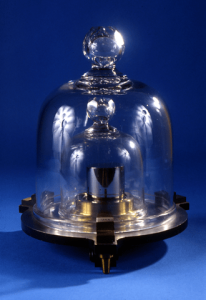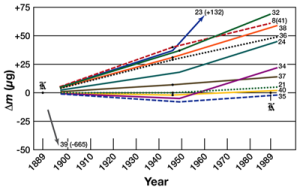Peter Lobner
Since my early science classes, I’ve been content knowing that a mass of 1.0 kilogram weighed about 2.205 pounds. In fact, the mass of a kilogram is defined to a much higher level of precision.
The U.S. National Institute of Standards and Technology (NIST) describes the current international standard for the kilogram as follows:
“For more than a century, the kilogram (kg) – the fundamental unit of mass in the International System of Units (SI) – has been defined as exactly equal to the mass of a small polished cylinder, cast in 1879 of platinum and iridium, which is kept in a triple-locked vault on the outskirts of Paris.
That object is called the International Prototype of the Kilogram (IPK), and the accuracy of every measurement of mass or weight worldwide, whether in pounds and ounces or milligrams and metric tons, depends on how closely the reference masses used in those measurements can be linked to the mass of the IPK.”
Key issues with the current kilogram standard
The kilogram is the only SI unit still defined in terms of a manufactured object. Continued use of this standard definition of the kilogram creates the following problems: lack of portability, drift, and scalability.
Lack of portability
The IPK is used to calibrate several copies held at the International Bureau of Weights and Measures (BIPM) in Sevres, France. The IPK also is used to calibrate national “primary” standard kilograms, which in turn are used to calibrate national “working” standard kilograms, all with traceability back to the IPK. The “working” standards are used to calibrate various lower-level standards used in science and industry. In the U.S., NIST is responsible for managing our mass standards, including the primary prototype national standard known as K20, which is shown in the photo below.
Drift
There is a laborious process for making periodic comparisons among the various standard kilogram artifacts. Surprisingly, it has been found that the measured mass of each individual standard changes, or “drifts,” over time. NIST reports on this phenomena:
“Theoretically, of course, the IPK mass cannot actually change. Because it defines the kilogram, its mass is always exactly 1 kg. So change is expressed as variation with reference to the IPK on the rare occasions in which the IPK is brought out of storage and compared with its official “sister” copies as well as national prototypes from various countries. These “periodic verifications” occurred in 1899-1911, 1939-53, and 1988-92. In addition, a special calibration, involving only BIPM’s own mass standards, was conducted in 2014.
The trend over the past century has been for most of BIPM’s official copies to gain mass relative to the IPK, although by somewhat different amounts, averaging around 50 micrograms (millionths of a gram, abbreviated µg) over 100 years. Alternatively, of course, the IPK could be losing mass relative to its copies.”
The NIST chart below shows the change in BIPM prototype mass artifacts (identified by numbers) over time compared to the mass of the IPK.
Scalability
The IPK defines the standard kilogram. However, there is no manufactured artifact that defines an international “standard milligram,” a “standard metric ton,” or any other fraction or multiple of the IPK. NIST observed:
“…..the present system is not easily scalable. The smaller the scale, the larger the uncertainty in measurement because a very long sequence of comparisons is necessary to get from a 1 kg standard down to tiny metal mass standards in the milligram (mg) range, and each comparison entails an added uncertainty. As a result, although a 1 kg artifact can be measured against a 1 kg standard to an uncertainty of a few parts in a billion, a milligram measured against the same 1 kg has relative uncertainties of a few parts in ten thousand.”
Moving toward a new definition of the standard kilogram
On 21 October 2011, the General Conference on Weights and Measures agreed on a plan to redefine the kilogram in terms of an invariant of nature. There are competing proposals on how to do this. The leading candidates are described below.
The Watt Balance
The Watt Balance is the likely method to be approved for redefining the kilogram. It uses electromagnetic forces to precisely balance the force of gravity on a test mass. The mass is defined in terms of the strength of the magnetic field and the current flowing through a magnet coil. The latest NIST Watt Balance is known as NIST-4, which became operational in early 2015. NIST-4 is able to establish the unit of mass with an uncertainty of 3 parts in 108.
You can read more about the operation of the NIST-4 Watt Balance and watch a short video on its operating at the following link:
https://www.nist.gov/pml/redefining-kilogram-watt-balance
Using a Watt Balance to redefine the kilogram introduces its own complications, as described by NIST:
“In the method believed most likely to be adopted by the ……BIPM to redefine the kilogram, an exact determination of the Planck constant is essential. And to measure the Planck constant on a watt balance, the local acceleration of gravity, g, must be known to high precision. Hence the importance of a head-to-head comparison of the gravimeters used by each watt-balance team.”
The 2012 North American Watt Balance Absolute Gravity Comparison produced the following estimates of the Planck Constant.
In this chart:
- Blue: current standard value of the Planck Constant from the international Committee on Data for Science and Technology
- Red: Values obtained from watt balances
- Green: Values obtained from other methods
The researchers noted that there is a substantial difference among instruments. This matter needs to be resolved in order for the Watt Balance to become the tool for defining the international standard kilogram.
International Avogadro Project
An alternate approach for redefining the kilogram has been suggested by the International Avogadro Project, which proposes a definition based on the Avogadro constant (NA). An approximate value of NA is 6.022 x 1023. To compete in accuracy and reliability with the current kilogram standard, NA must be defined with greater precision, to an uncertainty of just 20 parts per billion, or 2.0 x 10-8.
The proposed new standard starts with a uniform crystal of silicon-28 that is carefully machined into a sphere with a mass of 1 kg based on the current definition. NIST describes the process:
“With precise geometrical information — the mass and dimensions of the sphere, as well as the spatial parameters of the silicon’s crystal lattice — they can use the well-known mass of each individual silicon atom to calculate the total number of atoms in the sphere. And this information, in turn, lets them determine NA.
……Once the number of atoms has been resolved with enough precision by the collaboration, the newly refined Avogadro constant could become the basis of a new recipe for realizing the kilogram.”
 Kilogram silicon sphere. Source: NIST
Kilogram silicon sphere. Source: NIST
You’ll find more information on the International Avogadro Project on the BIPM website at the following link:
http://www.bipm.org/en/bipm/mass/avogadro/
Here the BIPM reports: Improvements of the experiments during the continued collaboration resulted in the publication of the most recent determination of the Avogadro constant in 2015:
NA = 6.022 140 76(12) × 1023 mol−1
with a relative uncertainty of 2.0 × 10−8
The last two digits of NA, in parentheses, are an expression of absolute uncertainty in NA and can be read as: plus or minus 0.000 000 12 × 1023 mol-1.
We’ll have to wait until 2018 to find out how the General Conference on Weights and Measures decides to redefine the kilogram.


